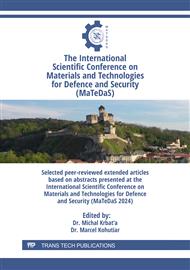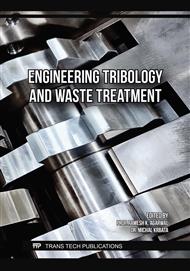p.3
p.11
p.19
p.33
p.43
p.61
p.71
p.77
Research on the Characteristics of Steels Essential for Increasing the Durability of Selected Special Equipment Structures
Abstract:
Various steels with suitable properties can be used as barrel steel. Most of the steels intended for the production of barrels are low or medium alloy steels. Barrel steels are significantly stressed by high pressures and temperatures during firing. During the shot, various forms of wear occur in the barrels, mostly abrasive, adhesive, and erosive wear. One of the most widely used steels for greater traction, from which barrels are made, is 34CrNiMo6. This steel is normally used for larger calibers, such as artillery, or for more stressed small-caliber weapons. This steel and its derivatives are the most widely used steels for the production of highly stressed barrels. We subjected the 34CrNiMo6 steel to tribological tests. In this article, we evaluated the coefficient of friction between 34CrNiMo6 steel and a G40 bearing ball. All measurements were performed on a UMT TriboLab universal tribo-meter (TA Instruments, New Castle, Delaware, USA) in dry conditions. The main goal of the experiments was to analyze the friction properties and wear of steel for the production of stressed 34CrNiMo6 barrels in contact with a G40 bearing ball with a diameter of 6.35 mm. In this evaluation of measurements, the authors of the article focused mainly on the influence of the peripheral speed on the change in wear and the coefficient of friction for two types of surfaces.
Info:
Periodical:
Pages:
33-42
Citation:
Online since:
June 2025
Keywords:
Price:
Сopyright:
© 2025 Trans Tech Publications Ltd. All Rights Reserved
Share:
Citation:



